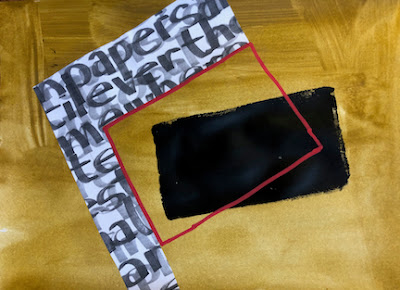The opening exercises in Lesson 3 of Jane Davies' on-line workshop focus on shape and line together.
We began by applying water to paper, and then adding drops of ink to create random shapes. We could manipulate these shapes by tilting the paper, allowing the ink to run amok. We could lighten the results by applying a paper towel to areas where the ink had pooled, lifting some of the ink. I also spritzed water onto the paper, to encourage more randomness in the results.
Once these papers had dried, we added line, using a variety of materials (graphite pencil, charcoal, paint marker, conté crayon). Sometimes the line might outline the shape; at other times it might ignore the shape. It could be a languid line or one full of energy, scribbled or precise, confident or hesitant. The lines could be separate from each other, or echo each other, or intersect.
I think the whole exercise is about honing our observational skills (how does this line relate to this shape?) as well as encouraging a variety of line.
Our next assignment began by laying down a wash of colour to make some backgrounds. (We had the option of using an unpainted background.) Then, we used paint to make a solid shape of any size. Next, we added a collage shape, and finally we added a third shape, using only its outline.
The final exercise of this Lesson 3 was to use black paint to draw the negative space in a still-life arrangement. In other words, don't outline your subject, but just go in there with your brush and paint what you discern to be the spaces between the shapes.
Some of the shapes could extend beyond the edge of the paper. Shapes could touch each other, or overlap each other, or remain separate.
We were to notice the edges of the shapes: were they soft, or brushy, or hard? Cut or torn?
Also to be noticed: rectilinear shapes vs. curving shapes...
... relative size of the shapes...
... alignment of shapes...
... busy areas vs. quieter areas...
... shapes inside shapes.
Again, these are exercises in observation, and noting all the ways of achieving variety. Even with the constraints, I'm beginning to think about composition. What do I find interesting? Why?
Continuing along with the line/shape dynamic, we made mini-compositions that conformed to our own parameters. For example, I chose to work with two shapes and one line.
It's not always clear to me whether a line functions as a line or as the outline of a shape.
Next, we were to return to some timed contour drawing that we had made in a previous exercise, and add "something" to them. Shown below are the original 60-second drawings, and the "something extra" added to them.
 |
| The teapot was painted white and a multi-coloured wash was added to the background. (Paper wrinkled.) |
 |
| Collage and watercolour were added. |
 |
| This drawing has the same subject as the one above, but was done with conté crayon, and was left "unimproved." |
The still-life sketch above was transformed
with the addition of oil pastel.
 |
| Collage and paint were added to the sketch. |
 |
| Watercolour was added. |






















No comments:
Post a Comment